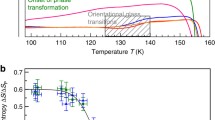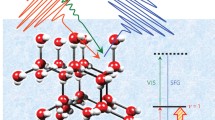Abstract
When an initially unpolarized HF doped ice specimen is warmed at a constant rate in an applied electric field two peaks are observed in the current. The low temperature peak occurs near 100°K and the temperature at which this peak occurs is seen to increase as the HF concentration decreases. The second peak appears to occur randomly in the temperature range 125–135°K. These peaks are also observed if the sample is cooled in an applied electric field and then warmed at a constant rate with the field removed. It is suggested that the first peak is due to a dielectric relaxation process which is governed by the L defects released from the HF molecules. This release of L defects is shown to obey the law of mass action with an activation energy for liberation of an L defect of 0.12±0.06 eV and a dissociation constantk o L≈1029 m−3.
A simple theoretical model of ice is also developed which predicts the current reversal phenomenon observed by Dengelet al. [11] suggesting that it is due to dipole relaxation and not to ferroelectric ordering.
Zusammenfassung
Wenn eine anfänglich unpolarisierte, HF-dotierte Eisprobe mit konstanter Aufheizrate bei angelegtem elektrischem Feld erwärmt wird, beobachtet man zwei Maxima des Stromes. Der temperaturmäßig tieferliegende Höchstwert tritt bei etwa 100°K auf, nämlich bei einer Temperatur, welche mit sinkender HF-Konzentration zunimmt. Das höherliegende Strom-Maximum tritt ungesetzmäßig im Temperaturbereich von 125–135°K auf. Beide Maxima werden auch dann beobachtet, wenn eine in einem elektrischen Felde abgekühlte Eisprobe nach Abschalten des Feldes mit konstanter Aufheizrate erwärmt wird.
Das untere Strom-Maximum wird einem dielektrischen Relaxationsprozeß zugeschrieben, welcher durch L-Defekte bestimmt wird, die von HF-Molekülen stammen. Es wird gezeigt, daß die Freisetzung der L-Defekte dem Massenwirkungsgesetz gehorcht mit einer Aktivierungsenergie für die Freisetzung eines L-Defekts von 0.12±0.06 eV und einer Dissoziationskonstantenk o L≈1029 m−3.
Ein einfaches theoretisches Modell für Eis wird entwickelt, welches die von Dengelet al. [11] beobachtete Vorzeichenumkehr des Stromes voraussagt und darauf hindeutet, daß sie einer Dipolrelaxation und nicht einem ferroelektrisch geordneten Zustand zuzuschreiben ist.
Résumé
Quand un spécimen de glace initialement non-polarisé et doté de HF se chauffe à un taux constant dans un champ électrique appliqué, on observe deux pics dans le courant. La pic à la température la plus basse se produit à environ 100°K et la température à laquelle ce pic se produit augmente à mesure que la concentration de HF diminue. La deuxième pic paraît se produire au hasard entre les températures 125–135°K. On observe aussi ces pics si l'échantillon se refoidit dans un champ électrique appliqué et puis se réchauffe à un taux constant après l'enlèvement de ce champ. On suggère que la premier pic est dûe à un processus de relaxation diélectrique que régissent les défauts L libérés des molecules HF. On prouve que cette libération de défauts L obéit à la loi d'action de masse, avec une énergie d'activation pour la libération d'un défaut L de 0.12±0.06 eV et une constante de dissociationk o L≈1029 m−3.
On développe aussi un simple modèle de glace théorique qui prédit le phenomène de renversement de courant observé par Dengelet al. [11], ce qui suggère que ce phénomène est dû à la relaxation dipolaire et non pas à la mise en ordre ferroélectrique.
Similar content being viewed by others
References
Pauling, L.: J. Amer. Chem. Soc.57, 2680 (1935).
Giauque, W. F., Stout, J. W.: J. Amer. Chem. Soc.58, 1144 (1936).
Bjerrum, N.: K. danske. Vidensk. Selsk. mat.-fys. Medd.27, (1), 3 (1951)
Pitzer, K. S., Polissar, J.: J. phys. Chem.60, 1140 (1956).
Rundle, R. E.: J. chem. Phys.21, 1311 (1953).
——: J. chem. Phys.22, 344 (1954).
——: J. phys. Chem.59, 680 (1955).
Peterson, S. W., Levy, H. A.: Acta. cryst.10, 70 (1957).
Whalley, E., Davidson, D. W., Heath, J. B. R.: J. chem. Phys.45, 3976 (1966).
——: J. chem. Phys.48, 2362 (1968).
Dengel, O., Eckener, U., Plitz, H., Riehl, N.: Physics Letters9, 291 (1964).
Van den Beukel, A.: Phys. Status solidi28, 565 (1968).
Pick, M. A.: Physics of Ice, Proc. Int. Symp., Plenum Press N.Y. (1969), 344.
Helmreich, D.: Physics of Ice, Proc. Int. Symp., Plenum Press N.Y. (1969), 231.
Bishop, P. G., Glen, J. W.: Physics of Ice, Proc. Int. Symp., Plenum Press N.Y. (1969), 492.
Engelhardt, H., Riehl, N.: Phys. kondens. Materie5, 73 (1966).
——, Bullemer, B.: Physics of Ice, Proc. Int. Symp., Plenum Press N.Y. (1969), 430.
Mascarenhas, S.: Physics of Ice, Proc. Int. Symp., Plenum Press N.Y. (1969), 483.
Glockmann, H. P.: Physics of Ice, Proc. Int. Symp., Plenum Press N.Y. (1969), 502.
Onsager, L.: Ferroelectricity (ed. E. F. Weller) Elsevier Amsterdam (1967), 16.
Kopp, M., Barnaal, D. E., Lowe, I. J.: J. chem. Phys.43, 2965 (1965).
Haltenorth, H., Klinger, J.: Physics of Ice, Proc. Int. Symp., Plenum Press, N.Y. (1969), 579.
Bucci, C., Fieschi, R., Guidi, G.: Phys. Rev.148, 817 (1966).
Fröhlich, H.: Theory of Dielectrics. Oxford: Clarendon Press 1949.
Powles, J. G.: J. chem. Phys.20, 1302 (1952).
Auty, R. P., Cole, R. H.: J. chem. Phys.20, 1309 (1952).
Abramowitz, M., Stegun, I. A.: Handbook of Mathematical Functions. Dover N.Y. (1965), 231.
Jaccard, C.: Helv. phys. Acta32, 89 (1959).
Cross, J. D.: Electrets. International Symposium (Ed. Baxt and Perlman). The Electrochemical Society N.Y. (1968), 45.
Macdonald, J. R.: J. chem. Phys.29, 1346 (1958).
——: J. chem. Phys.30, 806 (1959).
Author information
Authors and Affiliations
Rights and permissions
About this article
Cite this article
Chamberlain, J.S., Fletcher, N.H. Low temperature polarization effects in ice. Phys kondens Materie 12, 193–209 (1971). https://doi.org/10.1007/BF02422785
Received:
Issue Date:
DOI: https://doi.org/10.1007/BF02422785




